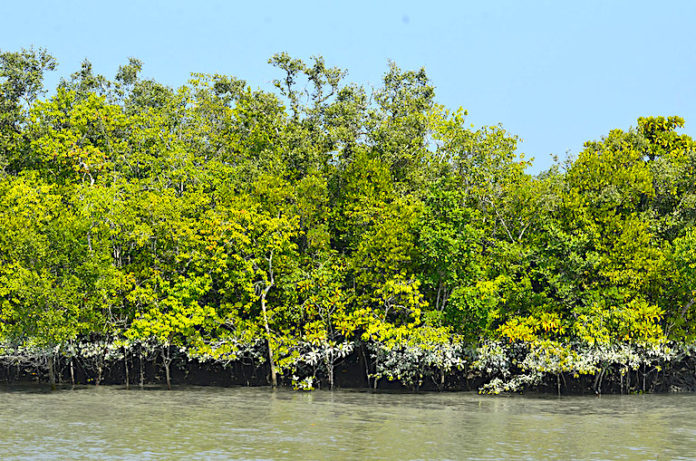
 By Mohammad Minhazur Rahman
By Mohammad Minhazur Rahman
Bangladeshi youths have taken a noble initiative, probably the most audacious action of this decade, to save the green belts of the Sundarbans. The Sundarbans mangrove forest, one of the largest such forests in the world, lies on the delta of the Ganges, Brahmaputra, and Meghna rivers on the Bay of Bengal.
The Sundarbans have been instrumental in protecting the people of Bangladesh and India from disastrous cyclones, typhoons, tsunamis, and other natural calamities for years after years.
“The Sundarbans prevented huge damage from the cyclonic storm Amphan. The Sundarbans has saved us,” says Md Moinuddin Khan, a forest conservator of the Khulna region.
The Sundarbans saved the coastal areas of Bangladesh from an inexplicable catastrophe.
The Sundarbans, indeed, saved the coastal areas of Bangladesh from an inexplicable catastrophe and reminded the people of Bangladesh about the importance of this mangrove forest’s mighty existence once again.
“The Sundarbans with its thick mangrove forest acts as a biological protective shield. The mangroves do not just help reduce wind speed drastically when the storm moves through the delta but even help break the waves and the surge triggered,” adds Mr. Khan.
Now with the aim of preventing the degradation of the Sundarbans, an initiative named “Project Oxygen” has been started by five Bangladeshi non-profits–Bandhu, Amrai Bangladesh, Project Pothchola, Give Bangladesh, and Project Konna. All of these organizations are run independently by Bangladeshi youths who have been volunteering selflessly for the socio-economic development of the country. The most interesting part is that the whole program has been funded alone by Bangladeshi youths. They have collected only 30 BDT (0.35 US dollars) for planting and taking care of each plant for 1 year. They have planned to plant 49,000 trees in different areas of Koyra, a remote coastal mangrove forest of Bangladesh that has been severely affected by the recent cyclone Amphan.
The Sundarbans located in the south-west of Bangladesh is the largest single tract mangrove forest and the UNESCO natural world heritage site. Extraordinarily rich in biodiversity, this beautiful forest (literal English for Sundarban) is intersected by a network of tidal canals, creeks, and rivers. More than 4 million people depend on the Sundarbans for their livelihoods. This has also been a huge natural safeguard against frequent cyclones, storms, and other natural disasters in the country. This is the strongest shield for the people to fight against climate change.
Lives and properties of almost 50 million people will be threatened if there is no Sundarban. The Sundarbans is home to hundreds of animal and plant species, including the endangered Bengal tiger (Panthera tigris), as well as the only two remaining species of freshwater dolphins in Asia — the threatened Irrawaddy river dolphin (Orcaella brevirostris), and the endangered Ganges river dolphin (Platanista gangetica).
But unfortunately, the Government of Bangladesh has been very ignorant of this globally unique World Heritage Property and the largest mangrove forest in the world. Sadly, the government has authorized a destructive project of building a coal power plant just 14 kilometers (~8.7 miles) away from the Sundarbans, which could ultimately damage its fragile ecosystem, threatening not just its wildlife but also the livelihoods of the thousands of people who depend on the massive mangrove forest. Conservation groups, environmentalists, and activists have strongly condemned the project.
This initiative of planting 49,000 trees is undoubtedly a strong protest against the autocratic and self-destructive decisions of the policymakers of Bangladesh.
Against this backdrop, the youths of Bangladesh were determined to do something by themselves for the conservation of this world heritage. This initiative of planting 49,000 trees is undoubtedly a strong protest against the autocratic and self-destructive decisions of the policymakers of Bangladesh.
The list of 49,000 trees includes 20,500 Lebbeck trees (Albizia lebbeck), 16,500 Lombu trees (Khaya anthotheca), 2000 Guava trees (Psidiam guajava), 2500 Wood Apple trees (Limonia acidissima), 3000 Palm trees (Borassus flabellifer), 2000 Tamarind trees (Tamarindus indica), 1000 Indian Gooseberry (Phyllanthus emblica) and other trees that have been recommended by Environmental Scientists and Forestry Experts. These trees would significantly strengthen the coastal areas of Bangladesh and protect this country from natural disasters.
17 local youth organizations of the Khulna district, with thousands of volunteers, have already agreed to take care of those trees voluntarily for 1 year so that those trees can grow properly. Moreover, 1000 underprivileged local residents of Koyra have been enlisted to take care of the fruit trees for a lifetime so that they can have fruits in return. The whole process of taking care of the trees would be monitored and followed up by the volunteers of the central organizations.
Ordinary people in Bangladesh, development organizations, corporate companies, non-profit organizations, and thousands of youths across the country have welcomed this initiative, and many of them have shown the willingness to work for the advancement of this project. Many of them are sending monetary assistance, facemasks, handwash, and other sanitary products for the volunteers of this project who have been working their best to strengthen the natural shield of this country amidst the critical situation of COVID 19 outbreak.
(Mohammad Minhazur Rahman studies law at the Jahangirnagar University, Dhaka, Bangladesh. He is interested in international law and aspires to work in the development sector. He has also been volunteering in different non-government organizations (NGOs) in Bangladesh).










